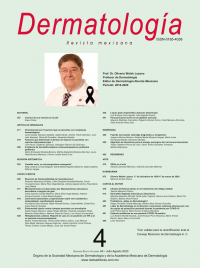Factors that determine the time of improvement in patients with type 1 lepra reaction.
Dermatol Rev Mex. 2020; 64 (4): 379-385.
John Nova,1,2 Guillermo Sánchez,1,3 Sebastian Ramiro Gil-Quiñones1,4
1 Hospital Universitario Centro Dermatológico Federico Lleras Acosta ESE, Bogotá, Colombia.
2 Médico, dermatólogo y magíster en Epidemiología.
3 Médico, magíster y PhD en Epidemiología.
4 Médico, Universidad del Rosario, Bogotá, Colombia.
Resumen
OBJETIVOS: Identificar los factores de pronóstico que se asocian con el tiempo de alivio de los pacientes, así como desarrollar un modelo predictivo que permita estimar el tiempo de alivio de la reacción.
MATERIAL Y MÉTODO: Estudio observacional, analítico, de cohorte, retrospectivo. Se tomó información de los registros de los pacientes que habían padecido episodios de reacción lepromatosa tipo 1 durante siete años. Se estimó la tasa de densidad de incidencia para el tiempo de alivio del episodio reaccional. Se utilizó el análisis de regresión de Cox para desarrollar el modelo de predicción del tiempo de alivio de la reacción.
RESULTADOS: Se incluyeron datos de 35 pacientes con eventos de reacción lepromatosa tipo 1. La tasa global de incidencia de tiempo de alivio de la reacción fue de 7.3 por 100 personas/mes de seguimiento (IC95%: 5.2-10.1). Con el modelo de predicción pudieron clasificarse los pacientes en dos grupos: los de peor pronóstico (35 meses para el alivio) fueron pacientes con lepra lepromatosa subpolar, necesidad de administrar dos medicamentos para controlar la reacción y existencia de neuritis y los de mejor pronóstico tenían lepra dimorfa y manifestaciones cutáneas únicamente.
CONCLUSIONES: Con el modelo propuesto puede predecirse el tiempo de alivio de los pacientes con reacción tipo 1.
PALABRAS CLAVE: Lepra; lepra lepromatosa; lepra dimorfa; reacción lepromatosa; pronóstico.
Abstract
OBJECTIVES: To identify the prognostic factors that are associated with the time of improvement of the patients, as well as to develop a predictive model that allows to estimate the time of relief of the reaction.
MATERIAL AND METHOD: A retrospective cohort study. Information was obtained from the medical records of patients who had presented episodes of type 1 lepra reaction during the years 2003 to 2009. The incidence density rate for the time of improvement of the reactionary episode was estimated. Cox regression analysis was used to develop a predictive model on reaction improvement time.
RESULTS: Data from 35 patients with type 1 lepra reaction events were included. The overall incidence rate of reaction improvement time was 7.3 per 100 people/month of follow-up (95% CI: 5.2-10.1). With the predictive model, patients were classified into two groups: those with the worst prognosis (35 months for improvement) were patients with lepromatous leprosy, requiring two medications to achieve control of the reaction; and those with better prognosis had dimorphic leprosy and cutaneous manifestations that improved in the first months of treatment.
CONCLUSIONS: Using the given model, the improvement time of patients with type 1 lepra reaction can be predicted.
KEYWORDS: Leprosy; Lepromatous leprosy; Dimorphic leprosy; Lepra reaction; Prognosis.

